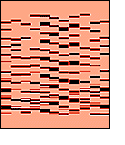Return to Online
Education Kit
|
 |
 |
 Previous Event | Next Event Previous Event | Next Event 
1975-77: DNA Sequencing
 Sanger and his colleagues, and Maxam and Gilbert developed rapid DNA sequencing methods. Sanger and his colleagues, and Maxam and Gilbert developed rapid DNA sequencing methods.
Sanger and his colleagues developed a slightly different protocol for sequencing DNA compared with Maxam and Gilbert. Sanger’s method, where a marker attaches to the growing ends of DNA chains, is used most commonly in labs now. In the past, scientists used radioactivity to mark the ends of DNA chains; now, they use colored dyes.
More Information
References:
Maxam, A.M., Gilbert, W. A new method for sequencing DNA. Proc Natl Acad Sci, 74 (2): 560-4. 1977. [PubMed]
Abstract: DNA can be sequenced by a chemical procedure that breaks a terminally labeled DNA molecule partially at each repetition of a base. The lengths of the labeled fragments then identify the positions of that base. We describe reactions that cleave DNA preferentially at guanines, at adenines, at cytosines and thymines equally, and at cytosines alone. When the products of these four reactions are resolved by size, by electrophoresis on a polyacrylamide gel, the DNA sequence can be read from the pattern of radioactive bands. The technique will permit sequencing of at least 100 bases from the point of labeling.
Sanger, F. and Coulson, A.R. A rapid method for determining sequences in DNA by primed synthesis with DNA polymerase. J Molec Biol, 94: 441-448. 1975. [PubMed]
Sanger, F., Air, G.M., Barrell, B.G., Brown, N.L., Coulson, A.R., Fiddes, C.A., Hutchison, C.A., Slocombe, P.M., Smith, M. Nucleotide sequence of bacteriophage phi X174 DNA. Nature, 265(5596): 687-95. 1977. [PubMed]
Abstract: A DNA sequence for the genome of bacteriophage phi X174 of approximately 5,375 nucleotides has been determined using the rapid and simple 'plus and minus' method. The sequence identifies many of the features responsible for the production of the proteins of the nine known genes of the organism, including initiation and termination sites for the proteins and RNAs. Two pairs of genes are coded by the same region of DNA using different reading frames.
 Previous Event | Next Event Previous Event | Next Event 
Last Reviewed: April 15, 2008
|

